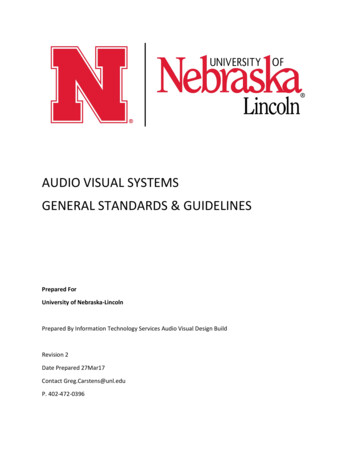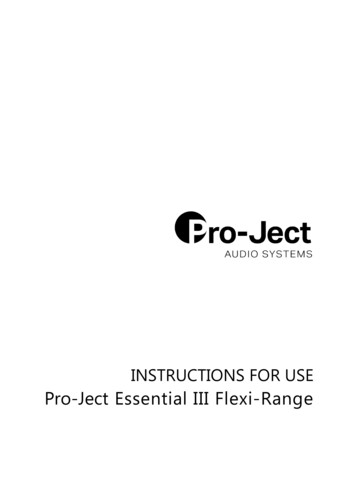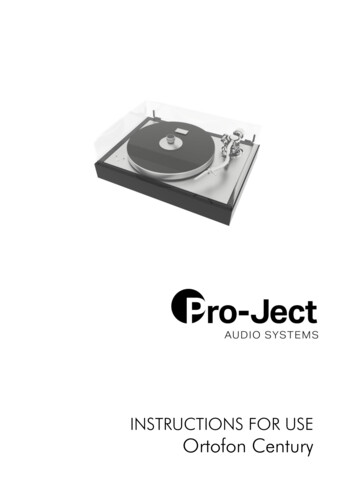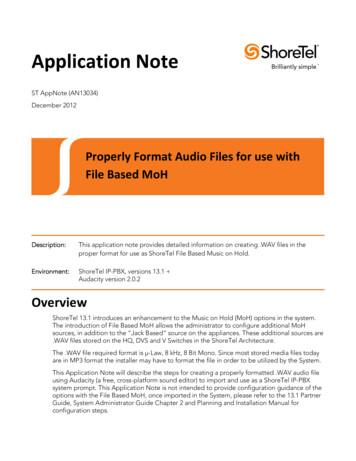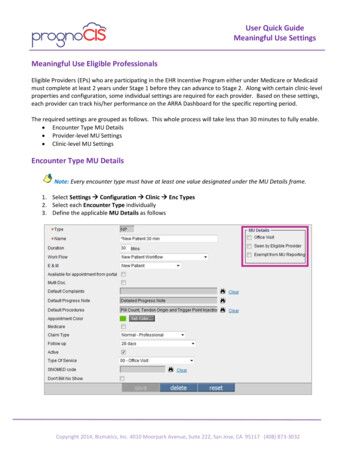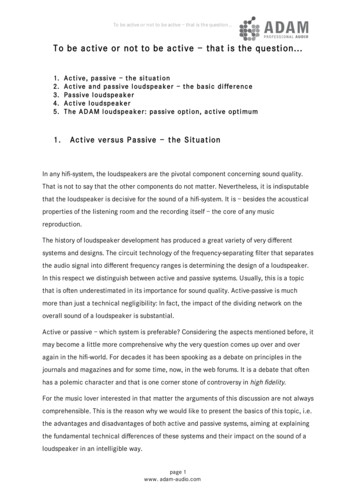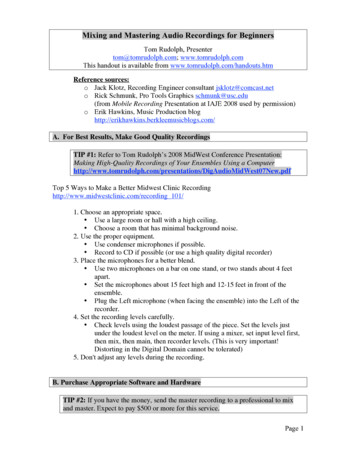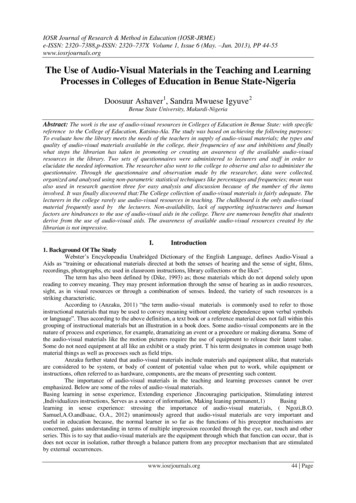
Transcription
IOSR Journal of Research & Method in Education (IOSR-JRME)e-ISSN: 2320–7388,p-ISSN: 2320–737X Volume 1, Issue 6 (May. –Jun. 2013), PP 44-55www.iosrjournals.orgThe Use of Audio-Visual Materials in the Teaching and LearningProcesses in Colleges of Education in Benue State-NigeriaDoosuur Ashaver1, Sandra Mwuese Igyuve 2Benue State University, Makurdi-NigeriaAbstract: The work is the use of audio-visual resources in Colleges of Education in Benue State: with specificreference to the College of Education, Katsina-Ala. The study was based on achieving the following purposes:To evaluate how the library meets the needs of the teachers in supply of audio-visual materials; the types andquality of audio-visual materials available in the college, their frequencies of use and inhibitions and finallywhat steps the librarian has taken in promoting or creating an awareness of the available audio-visualresources in the library. Two sets of questionnaires were administered to lecturers and staff in order toelucidate the needed information. The researcher also went to the college to observe and also to administer thequestionnaire. Through the questionnaire and observation made by the researcher, data were collected,organized and analysed using non-parametric statistical techniques like percentages and frequencies; mean wasalso used in research question three for easy analysis and discussion because of the number of the itemsinvolved. It was finally discovered that:The College collection of audio-visual materials is fairly adequate. Thelecturers in the college rarely use audio-visual resources in teaching. The chalkboard is the only audio-visualmaterial frequently used by the lecturers. Non-availability, lack of supporting infrastructures and humanfactors are hindrances to the use of audio-visual aids in the college. There are numerous benefits that studentsderive from the use of audio-visual aids. The awareness of available audio-visual resources created by thelibrarian is not impressive.I.Introduction1. Background Of The StudyWebster’s Encyclopeadia Unabridged Dictionary of the English Language, defines Audio-Visual aAids as “training or educational materials directed at both the senses of hearing and the sense of sight, films,recordings, photographs, etc used in classroom instructions, library collections or the likes”.The term has also been defined by (Dike, 1993) as; those materials which do not depend solely uponreading to convey meaning. They may present information through the sense of hearing as in audio resources,sight, as in visual resources or through a combination of senses. Indeed, the variety of such resources is astriking characteristic.According to (Anzaku, 2011) “the term audio-visual materials is commonly used to refer to thoseinstructional materials that may be used to convey meaning without complete dependence upon verbal symbolsor language”. Thus according to the above definition, a text book or a reference material does not fall within thisgrouping of instructional materials but an illustration in a book does. Some audio-visual components are in thenature of process and experience, for example, dramatizing an event or a procedure or making diorama. Some ofthe audio-visual materials like the motion pictures require the use of equipment to release their latent value.Some do not need equipment at all like an exhibit or a study print. T his term designates in common usage bothmaterial things as well as processes such as field trips.Anzaku further stated that audio-visual materials include materials and equipment alike, that materialsare considered to be system, or body of content of potential value when put to work, while equipment orinstructions, often referred to as hardware, components, are the means of presenting such content.The importance of audio-visual materials in the teaching and learning processes cannot be overemphasized. Below are some of the roles of audio-visual materials.Basing learning in sense experience, Extending experience ,Encouraging participation, Stimulating interest,Individualizes instructions, Serves as a source of information, Making leaning permanent,1)Basinglearning in sense experience: stressing the importance of audio-visual materials, ( Ngozi,B.O.Samuel,A.O.andIsaac, O.A., 2012) unanimously agreed that audio-visual materials are very important anduseful in education because, the normal learner in so far as the functions of his preceptor mechanisms areconcerned, gains understanding in terms of multiple impression recorded through the eye, ear, touch and otherseries. This is to say that audio-visual materials are the equipment through which that function can occur, that isdoes not occur in isolation, rather through a balance pattern from any preceptor mechanism that are stimulatedby external occurrences.www.iosrjournals.org44 Page
The Use Of Audio-Visual Materials In The Teaching And Learning Processes In Colleges Of(Eze,E.U. 2013) also states that the human being learns more easily and faster by audio-visualprocesses than by verbal explanations alone. His ability to arrive at abstract concept through perceptualexperience is however a phenomenon not clearly explained and perhaps not explicable.Furthermore, (Oketunji, 2000) stressed that audio-visual materials when effectively used have theseadvantages. They lessen major weakness of verbalism, humanize and vitalize subject matter, provide interestingapproach to new topics and give initial correct impressions, economic time in learning, supply concretematerials needed, stimulate the initiative of the pupils.Swank,R.C (2011). stressing the effectiveness of visual materials in leaning, estimated that about 40%of our concepts are based upon visual experience, 25% upon auditory, 17% on tactile, 15% upon miscellaousorganic sensation and 3% upon taste smell. With the above assertion, it becomes clearer why audio-visualmaterials are important in the teaching and learning processes. This is because, they bring the different sensescontributions together to get 100% clarity.2. Extending Experience:(Gopal V. P. 2010) stressed that audio-visual materials help the teacher to overcome physicaldifficulties of presenting subject matter. That is to say, with audio-visual materials, the barrier ofcommunication and distance is broken. The culture and climatic conditions of other countries can be broughtinto the classroom with the aid of slides, films, filmstrips and projectors. This is important because, according toDike (1993) “once the phenomenon is visualized, the picture and knowledge becomes very clear andpermanent”. Agreeing to this assertion, a 20th century Chinese philosopher stated that “one picture is worth athousand words”.3. Encouraging Participation(Natoli, C. 2011) once again added that “audio-visual materials are rich opportunities for students todevelop communication skill while actively engaged in solving meaningful problems”. In other words, studentscertainly like it more and learn better if they are engaged in important and appealing activities. For example,involving students in bulletin board display will enhance their choice of colour and aid their understanding ofthe concept in question or when they join the teacher in dramatization of an event or a process.4. Stimulating InterestAccording to (Katherine M. 2009) “learning takes place effectively when the teacher sets out to providelearning situation in which a child will learn because of his natural reactions of the provided materials”. Duringthe process of learning, the teacher has to provide the learning situation to satisfy the natural reaction of thelearner and this is through the use of instructional aids. The attention of the learner is caught and his interest isalso won and he is ready to learn.Fawcett Hills (1994) also contributing on the role of audio-visual materials in stimulating intereststated that “A friendly, accepting group climate is important in any learning situations, especially thosematerials that require students to reveal their ignorance and confront their fellow students”. When there is aclimate of acceptance for learning, then learning is stimulated.5. Individualise InstructionLestage A. (1959) stressed that audio-visual materials provide a means of individualizing instruction.This he said is possible through programmed learning and tapes which enable the learner to learn at his pace andalso to work on his own. Moreover, according to Dike (1993) the machine frees the teacher to work withindividual students, since he or she is not now required to carry out routine drills. Production of resources bystudents is another way of individualizing instruction.6. Serves as a source of informationAccording to Peterson, “the child is to think, but he must have the information to with”. This audiovisual resources serves, because, the information can be got from the good use of perceptual instructionalmaterials especially those provided from our locality. When they are used in the class, their familiarity gives aback-ground for understanding the information.(Mcnaught, A.2007) also observed that audio-visual materials are very useful teaching and instructionalas well as promotional aids. He further stressed that where consistency of presentation is desirable, audio-visualmaterials are useful. They provides experiences not easily secured in other ways and hence contribute to thedepth and variety of learning.www.iosrjournals.org45 Page
The Use Of Audio-Visual Materials In The Teaching And Learning Processes In Colleges Of7. Making learning permanentAudio-visual resources can play a major role of making learning permanent, (Gopal V. P. 2010)stressed that “audio-visual methods do seem to facilitate the acquisition, the retention and the recall of lessonslearned, because, they seem to evoke the maximum response of the whole organism to the situations in whichlearning is done. And perceptual materials readily associate themselves with the unique experiential backgroundof each individual. (Natoli, C. (2011) stressed that audio-visual materials are important in the teaching andlearning processes because “Having seen something, most people remember, for whatever that thing was, itconjures up an image at a mere mention and can be talked about freely.Dike (1993) also explained that students forget because of lack of interest and opportunities to use theknowledge they have gained later on. Audio-visual resources can therefore contribute to the clarity ofinformation presented by allowing students to visualize what is learned. Thus the saying:What I hear, I forgetWhat I see, I rememberWhat I do, I knowII.Statement Of ProblemThe study is motivated by the fact that students do not retain for long or understand what they aretaught without audio-visual aids. Such learning does not encourage participation and lacks interest orstimulation. It is not based in sense experience nor does it extend their experience. Above all, such learningcannot be permanent. Yet, there is also evidence of low utilization and non availability of audio-visual materialsin schools. The study will therefore investigate materials in colleges of education in Benue state, the traininginstitution for future teachers. So that note will be taken of the hindrances and work towards promoting the useof audio-visual materials.Purpose Of The Study1.The purpose of this study is to discover and document the use of audio-visual aids in teaching andlearning processes in the Colleges of Education in Benue state with particular reference to the college ofeducation Katsina-Ala.2.It will also evaluate how the library meets the needs of the teachers in supply of audio-visual materials.3.The study will also bring out the types and quantity of audio-visual material there are in the collegelibrary, the inhibitions to their use and the frequency of their use by the lecturers.4.It will investigate what steps are taken by the librarian to create awareness of the available audio-visualmaterials to the lecturers.1.4 Scope Of The StudyThe study is limited to the College of Education Katsina-Ala in Benue State but the results of the studyjust like any other study can be used to rectify the hindrances in colleges of education in Benue State andNigeria at large.The study is also limited to the use of audio-visual resources in teaching and learning processes, theireffectiveness and capabilities in facilitating the flow of information between the teacher and the learners.1.5 Significance Of The StudyAudio-visual materials have been in existence for a longtime, but they are often underutilized. It isexpected that, following the identification of the hindrances to maximum utilization of audio-visual resources inschools, effort will be made to minimize the effect of the hindrances and promote adequate utilization of theavailable resources. Discoveries from the study will guide teachers, government, sponsoring bodies and donorson the purchase of not only printed materials but also non-print materials for schools and colleges. When the useof audio-visual materials is encouraged, there will definitely by a high demand for the materials and theproducers will put in more efforts in the production and even come out with more methods of applying them toteaching and learning. This may tend to expose the learner more to thinking than relying on the teacher. Theresearch will also pave the way for research into other areas of concern and interest and will give researchersinsight into this topic of investigation.1.6 Research Questions1. What types and quantity of audio-visual materials are available in the college library, College of EducationKatsina-Ala?2. How often do lecturers use audio-visual materials while teaching?3. What type of audio-visual materials do lecturers use?4. What are the hindrances to the use of audio-visual materials in college?www.iosrjournals.org46 Page
The Use Of Audio-Visual Materials In The Teaching And Learning Processes In Colleges Of5.6.In the perception of lecturers, what benefits do students derive from the use of audio-visual materials?What steps has the librarian taken to increase the use of audio-visual materials among teachers?III.The General Over-View Of Audio-Visual MaterialsProstano and Prostano (1982) asserted that the time immemorial, audio-visual materials existed butwere not incorporated into educational system”. According to the authors, the advent of audio-visual materials islong but it is the use that has been limited until in the 1960s and 1970s that libraries realised the use of thesematerials and started incorporating them into the library collections for future use. Summer stressing on theadvent of the materials stated that “before man developed speech as a means of communication, he expressedhimslelf in terms of drawings, signals and symbols”. The point here is that the use of audio-visual materialsstarted as early as man’s civilization begain. This is evident in their attempt to communicate ideas. Green (1965)has this to say; “in time of antiquity, man carried pictures on rocks for conveying ideas”.Ani (1990) supporting the introduction of audio-visual aids observed that as far back as the 1920saudio-visual materials came to be used in teaching in the United State of America. According to Dike (1993),the various methods of teaching informally such as observation, participation and the use of the senses are formsof audio-visual resoruces in our indigenous Nigerian Education. The child is asked to observe carefully withoutverbal instructions and to participate in domestic science, craft, and agriculture, the child is able to graspknowledge from different fields unconsciously.Thus every child has the right to knowledge and informationespecailly that which concerns his cultural heritage”. It is imperative theirefore that in cultures whose traditionsare essentially of the oral rather than the writer kind, knowledge and information transfer be effected by usingverbal instructions and the preservation of their cultural arts. This is the meaning of the story telling sessions inour indigenous African education.In modern times, the value of insttuctional materials has been realised of late in this country andattempts are being made by all organs connected with education to see that audio-visual materials are used inteaching and learning situations. For examples, University of Nigeria, Nsukka has established CurriculumDevelopment and Instructional Materials Centre (CUDIMAC) to promote the utilization of various types ofaudio-visual resoruces and media in the school.In advances in librarianiship, (Hallett,T.L.andFaria,G. 2006) points out that, books are not the only waythe libraries can extend the available information to the public but other means such as pictures, filmstrips,slides, recording etc. should be acquired to suppliment book resoruces and to substitute for books when they arenot available on a particular topic. That is, in the modern educational methods modern technologies have givenrise to various means of teaching which make it easier for both the teacher and learner to achive their aims ofteaching and learning.The Encyclopeadia of library and information science asserted that libraries serving formal educationhave tended over the years to broden their inventories of non book or audio-visual materials rapidly and toaccept increased responsibiliteis for distribution of audio-visual equipment, e.g emotion pictures, projectors aswell as establishing local duplication and production services (e.g. of overlay transporencies).IV.Types Of Audio-Visual MaterialsThere are different ways of classifying audio-visual materials. As listed by (Fayemi,T.A) together withthe nessary related equipment for putting them to work in the classroom, audio-visual materials include thefollowing:REALIA in social and physical environmentThese materials, situations, and the people have to be visisted, studied, observed, reacted to and workedwith, right in their natural environment. The study of relia may then demand field trips, demonstration,experiments and other direct experiences as processes for getting the meaning. They may come into the class indisplay cases or attached on bulletin boards.Dramatic performances (portrayal of people, events, procedures) dolls and puppets are produced for use asdramatic models.Models, Mock-ups Globes, and Relief Maps. These can be purchased or produced by the teachers and studentsjointly. Exhibits and dioramas made up of models can be borrowed, purchased or constructed.Television programmes: This requires television receivers and antenna systems. They can be produced jointlyby students and teacher as learning experiences.Motion pictures: Projection equipment for accommodation either optical and/or magnetic sound tracks andprojection screens are required. Still pictures projection materials include transparencies and microprojector materials (microscopic slides and microscopic slides and microscopic objects).Study prints and pictorial illustrationsRadio and Audio programmes, as found in tapes or disk recordings and radio broadcasts.www.iosrjournals.org47 Page
The Use Of Audio-Visual Materials In The Teaching And Learning Processes In Colleges OfGraphic materials such as maps, graphs, cartoons, diagrams and charts.According to (Aina,M.E .and Olutade S.A. 2006), the chief visual tools which can be used by theteacher may be classified as follows:Pictorial and Graphic AidsChalkboardTextbooks illustrationsChartsPictures (a)Drawing(b)Reproductions(c)PhotographicMaps of various typesDiagrams. Picture language (Isotype, etc)Optical AidsEpiscopeDiacopes(a)Standard Lantern(b)Sub-standard slide projector(c)Strip projector(d)Micro-slide projector16mm Cinematograph(a)Silent(b)SoundSpecimens(a)Actual objects(c)Facsimiles or reproductionsModels (a)Reduced(b)Enlarged(c)Sectional(d)Working, included real objects e.g. school visitsThe direct experienceThe contrived experience or “Mock-up”Dike (1993) grouped audio-visual materials into:Audio resources such as records, tapes and cassettes, and radio broadcasts.Visual resources including models, real objects, three dimensional displays, the chalkboard, bulletinboard, adhesives, graphs, diagrammes, charts, maps, cartons, posters and pictures and projected forms liketransparencies, slides, filmstrips and films.Audio-visual combinations e.g. sould film and filmstrips, slides-tape decks, television programmes, videotapesand dramatization.Others such as educational programmes/games, programmed instructions, demonstration and field trips.From the above we can see that A/V resources are divided into audio visual and a combination of audioand visual resources and others which are class with audio-visual resources which can either be in a projected ornon-projected forms.V.Description Of SampleThe population of the study comprises all the lecturers and students in the College of EducationKatsina-Ala. There are about two hundred and thirty six (236) lecturers in the school and three thousand sixhundred and seventy five (3,675) students for the 1998/99 academic session, excluding remedial andpreliminary studies students.Sampling MethodA total number of sixteen to twenty students are selected from each of the faculties (which are called schools inthe college) in order to ensure fairness.www.iosrjournals.org48 Page
The Use Of Audio-Visual Materials In The Teaching And Learning Processes In Colleges OfTable 1: Faculties and number of respondents from students and staffFacultyFaculty of EducationFaculty of LanguagesFaculty of Social SciencesFaculty of Natural SciencesFaculty of Vocation EducationFaculty of 00This method of sampling is called stratified random sampling. The selection was done to ensure therepresentation of every faculty or to proportionately represent each group in the population.By doing this, the researcher gave more attention to the faculties than departments. In each faculty,students were randomly given the questionnaire bearing in mind the year of study of each of them so that theinformation collected will cut across the students of various levels in the faculty. To ensure this on the part ofstudents and their lecturers, their year of study and rank of the lecturers, were sought to know before given thequestionnaire to them.These lecturers are made up of different designations ranging from Lecturer I, Lecturer II, Lecturer III,Assistant lecturer, Senator Lecturers, Principal Lecturer and Chief Lecturers. Some of the students are in partone, some in part two and three. Their mode of entry is either through College of Education, JAMB (JuniorJAMB) or after passing their Preliminary Studies in various departments. The sample population thereforeconsists of such students and lecturers.The sample population is taken from these groups because, they are the people involved with the use ofaudio-visual materials while teaching and learning respectively. For these reasons, they are in a better positionto give the required information concerning audio-visual materials as regards their usefulness, availability, howoften they are used in teaching and the level of improvisation.VI.Instrument For Data CollectionThe instrument used for data collection in this research consisted of two sets of questionnaire forstudents and lecturers. The questionnaires were designed by the researcher in close consultation with hersupervisor. The questions were set to match the research questions in chapter one. The questionnaires weremade up of both fixed response and open – ended questions because of the nature of the study which desires toknow the forms, aspects and details about the use of audio-visual resources in the college.There were many categories of options or responses to each question in the questionnaires. These rangefrom very often, often, sometimes, never, very adequate, fairly adequate, rarely, encouraging, fairlyencouraging, not encouraging. In completing the questionnaire the questionnaire, 98 copies were returned by theteachers.The number of questionnaire for both students and teachers were some (one hundred copies)irrespective of the differences in the population. This is because, the researcher wanted to get a meaningfulnumber of respondents from the lecturers who are supposed to be the actual users of audio-visual aids to teachthe students. The response from the students is just supplemental to those of the lecturers.Method Of Data CollectionThe researcher visited the college physically to administer her questionnaire and also to observe whataudio-visual materials there are in the college. The questionnaires were given by hand to students and lecturersand collected on the sport within two days.Method Of Data AnalysisThe data collected for this research work were organized and analysed. Because the data obtained inthe study are mainly descriptive, non-parametric statistical techniques such as percentage, frequencies ofnumbers converted into percentages, in one case mean is used as means of analysis were used in the analysis.This helped to analyse the answers to the questions in the questionnaire and draw conclusion.VII.Data Presentation And AnalysisPersonal DataThe results of the questionnaires are analysed considering the answers of both the lecturers andstudents.www.iosrjournals.org49 Page
The Use Of Audio-Visual Materials In The Teaching And Learning Processes In Colleges OfTable 2: Rank of LecturersNo.ABCDEFGHIRank of LecturersReaderChief lecturerPrincipal lecturerSenior lecturerAssistant lecturerLecturer ILecturer IILecturer IIIOthersTotalNumber of respondents111616101022994In answering the above question, eleven lecturers marked chief lecturer, sixteen principal lecturers,sixteen senior lecturers ten assistant lecturers, ten lecturers I, twenty two lecturers II, nineteen lecturers III,nothing for readers and others, bringing the number to a total of ninety - four (94).Table 3: Teaching Subject of LecturersS/No.1234567891011121314Teaching SubjectEducational subjectAgricultural sciencesBiologyIntegrated scienceFine and Applied ArtsTheatre ArtsEconomicsGeographyHistoryEnglish languageChristian Religious StudiesSocial studiesPolitical scienceGeneral studiesTotalNumber of respondents124475848786108394The above table shows the number of respondents and different teaching subjects who were engaged inanswering the questionnaires for the research.VIII.Research QuestionsResearch Question 1How adequate is the college’s collection of audio-visual materials?Table 4: Adequacy of Audio-Visual MaterialResponse from LecturerResponse VeryFairlyInadequateadequate adequateFrequency 22261%2%23%65%Noresponse910%Total94100Table 4 shows that out of the 94 lecturers studied, 65% of them stated that the college’s collection of audiovisual materials is inadequate.The same question was given to students but in another from, - what is the quantity of audio-visual resources inyour school?Table 5: Adequacy of audio-visual materialsResponse from LecturerResponse Encouraging FairlyNotNoTotalencouraging encouraging responseFrequency 1044341098%10%45%35%10%100www.iosrjournals.org50 Page
The Use Of Audio-Visual Materials In The Teaching And Learning Processes In Colleges OfFrom the data obtained on research question I from students, a total number of 98 students were studied and 10percentage of the total number stated that the college’s collection of audio-visual materials is encouraging, 45%said it is fairly encouraging and 35% not encouraging, another 10% did not respond to the question. Based onthe number that responded to the question therefore, it is evident that students found the college’s collection ofaudio-visual aids fairly adequate while the lecturers said it is inadequate.The researcher was also there herself. Observation showed that the quantity of audio-visual materialsavailable in the school is fairly encouraging. I discovered they have some audio-visual materials in the librarywhich lecturers more often than not use. There is another media centre controlled by a lecturer of theeducational technology, which I made effort to see and hear from him to no avail. There is also a languagelaboratory which is newly established for effective teaching of languages and language skills. To be specific, thelibrary’s collection of audio-visual resources is inadequate, but with what I saw in the language laboratory isimpressive and same was said of the media centre.Another question was asked on the level of improvisation of these materials in the school: which of theaudio-visual materials do you improvise? Lecturers when asked the above question replied that they doimprovise some of the materials at their reach, improvise as in bringing them from their homes, e.g. suchmaterials like models, maps, magazines, newspapers, radio, specimens, posters, pictures and cassette recorders.5% of them stated that they do improvise.Research Question 2How often do lecturers use audio-visual materials in teaching?Table 6: Frequency of UseResponse from LecturerResponse OftenRarelyNeverTotalFrequency 23502598%23%51%26%100The table for research question 2 indicates that a good number of the teachers rarely use audio-visualresources in teaching. According to the table and the data collected, 51% of the lecturers rarely use audio-visualmaterials, 26% of them don’t use or have never used audio-visual materials; 23% often use audio-visualresources. Therefore, it is concluded that the lecturers in the college RARELY use audio-visual resources inteaching.Research Questions 3What types of audio-visual materials do lecturers use? Lecturers were asked how often they use thefollowing A/V materials in teaching. In the analysis of this question, because of the number of items, mean hasbeen chosen to explain the figures. The various alternatives for the question are:Very often VOthe alternatives were ranked in thisOften Oorder 4, 3, 2, 1Sometimes SNever
climate of acceptance for learning, then learning is stimulated. 5. Individualise Instruction Lestage A. (1959) stressed that audio-visual materials provide a means of individualizing instruction. This he said is possible through programmed learning and tapes which enable the
